“If you think about it, creativity is the opposite of violence. It can bring social change without violence. I deliberately paint for both intellectuals and people who don’t read because a lot of my people don’t read.”
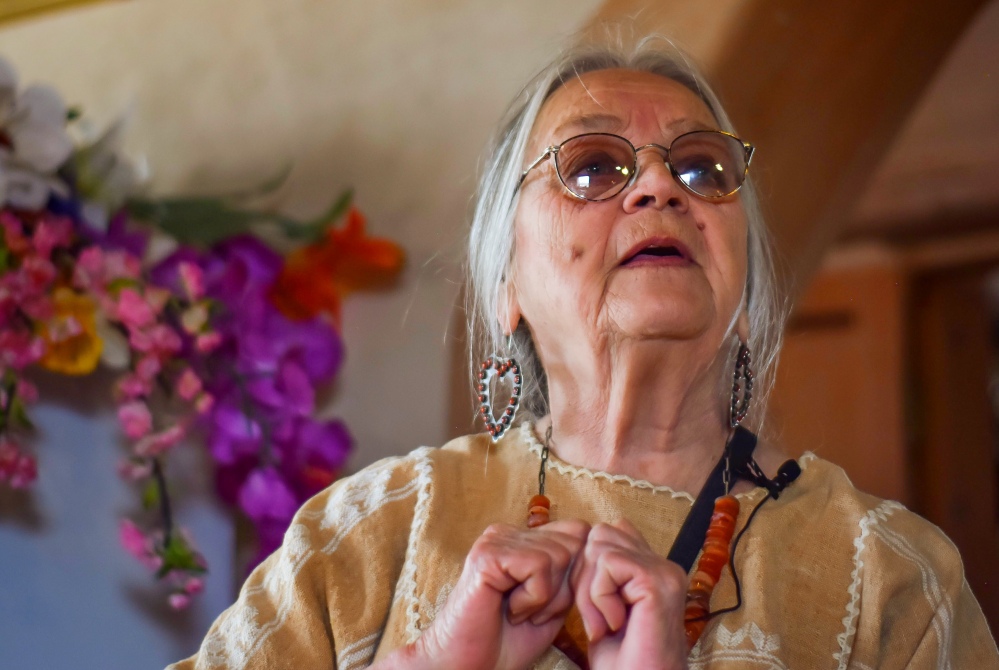
My name is Anita Otivero Rodriguez and I was born and raised here in Taos. I was born in 1941, I’m 76 years old and in my life I have been a mother, a painter, a construction worker, an enjarradora, and a writer, and I have had a life that even I can’t believe. I like my new pigeon hole, which is a legacy Hispanic.
Hispanic is like this generic term that includes everybody who speaks Spanish no matter what country they are from. But Legacy Hispanic reflects that fact that the population here in el norte is unique among Hispanics in that we are the closest thing to Indigenous of any people in this part of the Americas.
We are Indian, we are genizaros, and we are so deeply rooted here. It’s a feeling that we share among ourselves like a field of consciousness that somehow being Taoseno really means something. So in a way we’re kind put off when other people say “I’m local” and we are all tempted to say “oh yeah”.
There isn’t a generic opinion on what it means to be Taoseno, if you want to know how many opinions there are on that subject multiply our population by two. But I can tell you what it means to me. What it means to me is that this earth here where I was born and where my ancestors planted and ate the corn for many generations is a living breathing conscious being that I love with a deep passion… yeah this is my tierra, this is my tierra natal. Even in Spanish there isn’t a word for dirt, tierra means your birthplace, the land, but the very dirt like when you put your hands in the dirt in your garden.
I have two children, I have one son who lives in England and my daughter lives across the highway. She came back after leaving, like a lot of people do; we all come back if we can.
I’m originally from Taos, you know like from way back, we figure that the Trujillo’s which is the Native branch of the family, which has like 12% Native American came with La Reconquista so we’ve been here for about 300 years, so we feel grounded.
I grew up practically right on the plaza; my father had a drugstore on the plaza and so I grew up right in the heart of Taos. But I’ve lived in Arroyo Seco, I’ve lived in Llano, I’ve lived in Ranchos, I’ve lived in Egypt, I’ve been to Spain, I went to china, I’ve lived in Mexico, but this is where I want to be.
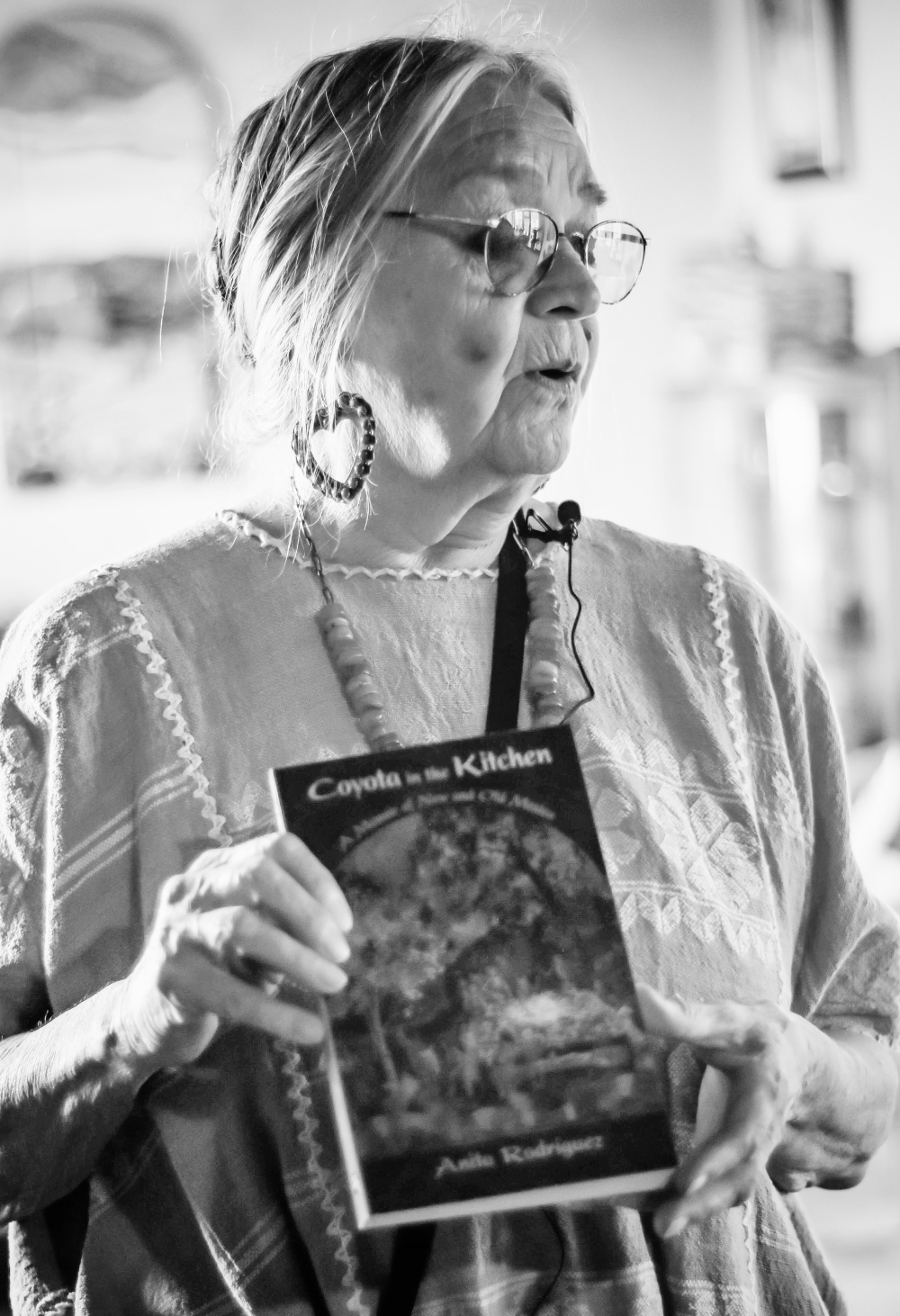
The cover of my cookbook is the painting that’s hanging in my bedroom. I painted all the characters in the book and they are sitting down at the table and this is a family that would never ever have eaten together if it had not been for the fact that for some improbable reason my Anglo mother came to Taos to study art and met my handsome Mexican father and he made her a chocolate soda and everybody loves chocolate. A few years later my sister and I were born, but these were people who came from totally different cultures and from totally different classes. My father’s people were really poor, they were native Taoseno’s. My mother’s family on the other hand lived in an Antebellum Mansion and it’s in a book today of historic houses in New Mexico. My mother had never peeled an onion in her life. So these two families met and mixed. Not only was it a color line that nobody else had crossed in that generation, it gave me a really interesting perspective on life because I think I saw at an early age that class just didn’t make sense to me and neither did racism and I can see that it was a big deal and everybody would say “oh que bonito el bebe parese gringo”. So those are the characters, and they were characters! My grandmother’s uncle, cousin Niles was the guy who built the Antebellum Mansion and he was a little short guy, and he had a round pot belly. So it was a very improbable family.

Artwork
Let’s talk about the art a little bit.
Look at this one, coyota is was what I was called as a child because of my racial mixture. My mother was Anglo, pure white and my father was Mexican, Native American and Spanish. So I am fascinated with double identity, with bilinguality, with the fact that all of us kind of lead double lives. We have a certain style at home and then we have to go get the job and you know do the mainstream thing and not scare them too much tu sabes, you know.
So these paintings, these nichos, they allow me to tell two stories at the same time. This is Las Posadas which you know happens in the villages around here to this day. But you open up the doors and the secret is revealed, and here is a Crypto Jewish family looking out the window at the church and the Catholic procession secretly performing their rites. Native American people do this, gay people do this, lesbian people do this, in a sense, we all do this. I mean you have the professional personality, you have the father, you have the son, you have the brother, you have all these different men living inside of you, you even have women living inside of you.
So you see the nicho’s are really versatile, and nobody has copied me! This one is another one, all the door pulls are precious and semi-precious gems, this one never sold because thank God it split, it’s a really good painting. It shows Meztizaje, on the outside this is anywhere in the America’s on market day when the Indigenous people come down con sus cositas para vender. 500 years ago it’s the same place, the same foundations the churches were built on, the temples, the people are there with their same costumes y todo.
This is my altar, and that’s, St. Death, La Santisima Muerte, La Niña Blanca, La Pelona, La Huesuda, she has a lot of names. When I was in Mexico the war started with the cartels and something like sixty thousand people have vanished and that is probably way low. She’s pre-Columbian. The catholic church has tried to stamp her out and her cult but they’ve never succeeded and she is kind of like this underground river in the Mexican psyche. When her people need her, she fills up and when the war started and people started disappearing and there were these grisly murders and just horrible things happened, you know tiro en cabezas, en resturantes, it was terrible. Shrines to her sprang up all over Mexico, all along the highways, housewives put them in their windows, people became bishops, they were in the mercado’s, it was everywhere, t-shirts, everything.
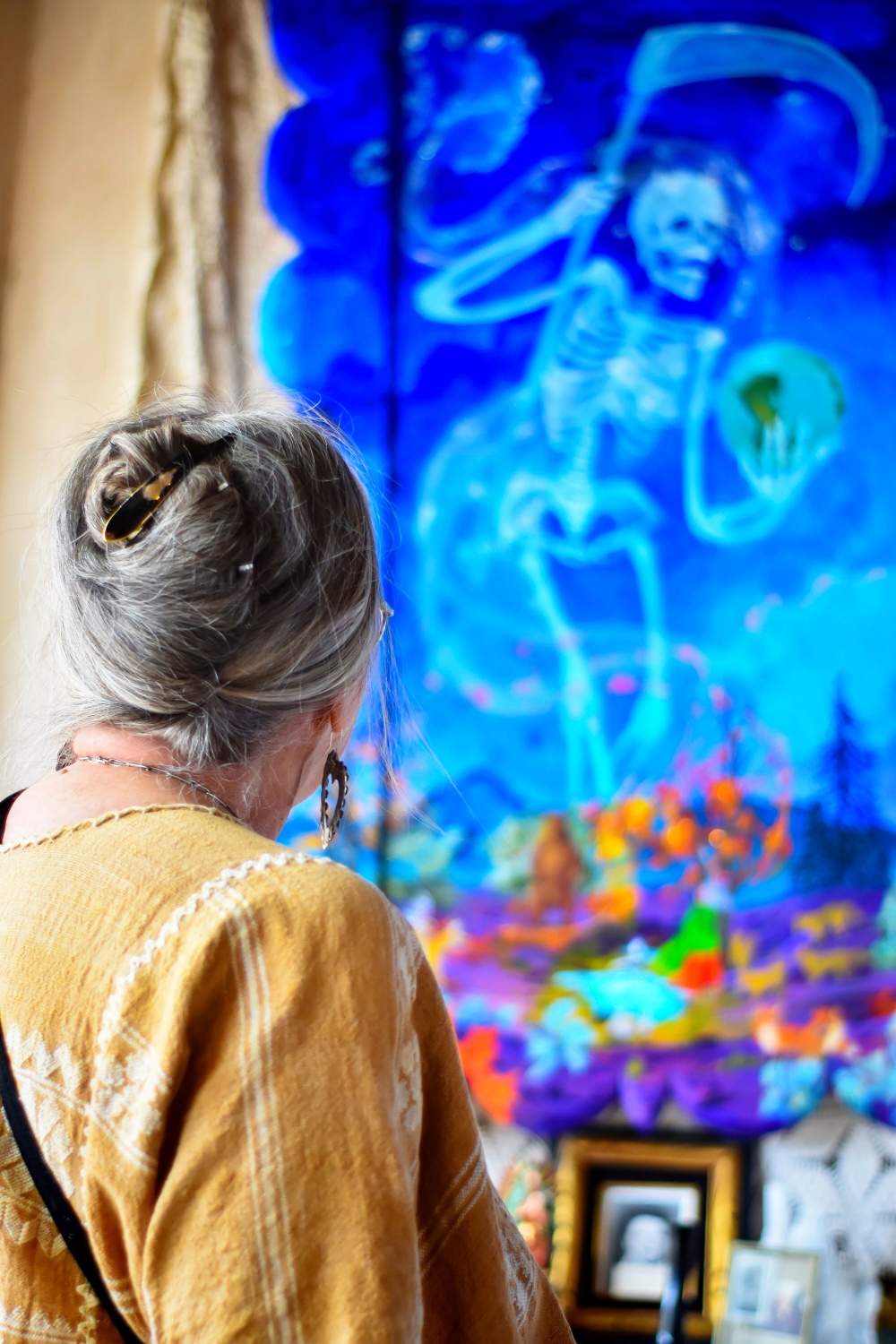
I knew a curandero who lived in the town, I knew a lot of them, but I knew one and he said “pinta me una santisima muerte and then I’ll let you paint me and I’ll let you take notes,” and you know I am a writer and a painter, so I did. I was walking down the plaza with the finished painting under my arm in this town where I have already lived for about ten years and was very conspicuous. I had the painting and these men said “podemos comprar la pintura”, I said “no it was sold.” At that time everyone had PTSD. We would end up holding hands and crying because we had children. It was during the swine flu epidemic as well. They said the reason she’s out and the reason she is on the streets is that she is trying to tell us something, like “look at your beautiful planets, look at what you have!” And down here is a woman with one eagle feather like at standing rock and everywhere it’s the black snake people, in the Middle East, in the Ukraine, in Nigeria at standing rock, at Oak Flats in Canada It’s all the same people, it’s all the black snake people. It’s all about those people.
This is San Ysidro the patron saint of farmers; this is El Angel el Santo y las Acequias. Las Acequias del norte son entre las cisternos de agua mas antiguas en el mundo con la naturlaleza y la tierra. You know the story of San Ysidro? Well he was like really a good man but he was very poor and he had to work one Sunday because it was the only day they would give him the irrigation water, he just had a little tiny tierrenito and he was not very important. So everybody else was going to church, you can see them there and poor San Ysidro was out and he was irrigating and angel came and said “mira Ysidro, you go to mass and I’ll irrigate.” It’s usually with a plow but I wanted to paint water.
The agricultural effects here in Taos has changed radically, like everything else. This painting speaks to that because it shows how the aquifer is replenished by the acequias and how the acequias keep the town green and how the buildings keep the people together. The acequias keep the people together and the land. The people formed this mutual symbiosis that is healthy.
Instead of what is this attitude that everything they find is like “can I sell it? Maybe I can eat it? I can develop it, I can market it, maybe I can screw it,” you know instead of just leaving it alone.
I have kind of a pre-Columbian streak in me, you know that escaped like this European, calvinist puritanism that characterizes our culture that is anti-sensuality, anti sex, anti-woman, anti-nature.I am kind of like against that because it’s part of life and if you are frustrated, it becomes perverted, which is much worse.
You know what is really obscene, are all these children disappearing while everyone is all excited about Trump. Oh let me show you my Trump Piñata! I had a party and I’m going to have a party every month until Trump is out of office! At each one I am going to have an artist and I made this piñata and grown adult people freaked out! I have photographs and videos of them, I filled it up with tootsie rolls. I may see if there is a need for it and they want it. Immigrant kids are the suffering more than anybody else right now and I was wondering if I could get artists in my community to volunteer to teach them art and you know what they want? They want to make Trump piñatas, so maybe we can make that and some paper mache Santo Divino’s too to have a little something positive.
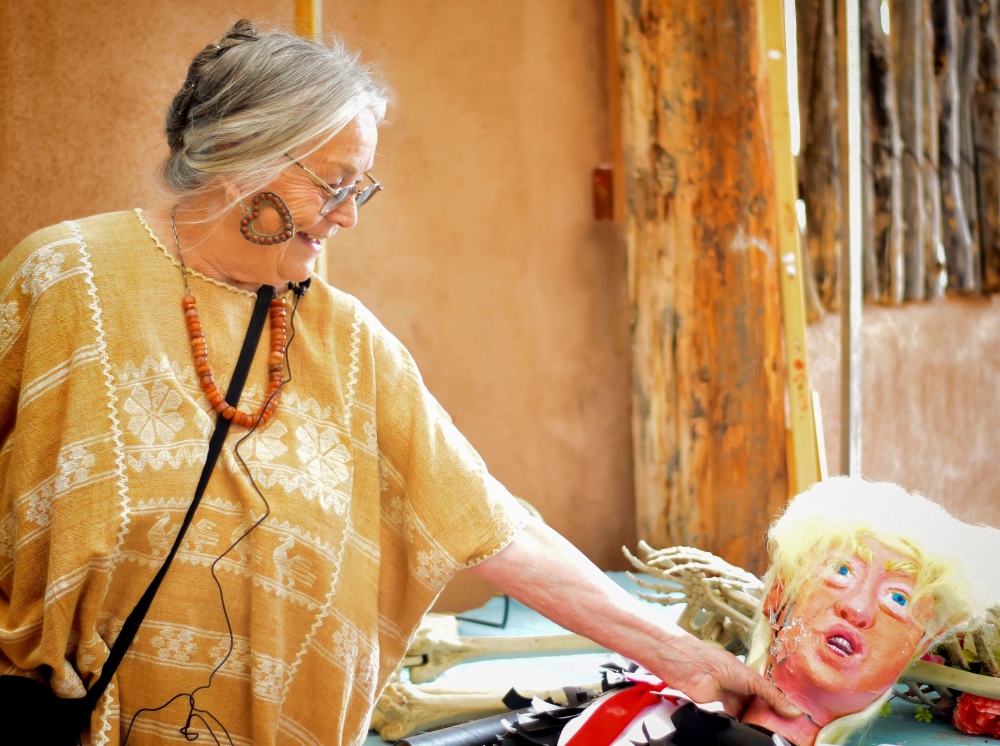
Well I don’t have a genre and I don’t have a style and that’s really a problem, because finding a context that you can fit in is like really important. You have to be kind of like the stereotype of that stereotype or something like it. The latest label that I feel most comfortable with is Magical Realism and I am also really found that our new category it’s like now we are Legacy Hispanics.
In my lifetime I have changed from let’s see… we started out as Spanish Americans, then they changed us to Mexican Americans, and then I think there was Chicano, and then Hispanic became official, and now those of us from Northern New Mexico are Legacy Hispanics, which I kind of like.
I read a lot you know and I read a lot of psychology and I really like Jung and I like the idea of archetypes, which are kind of like psychic organs. All human beings have livers, lungs, you know, no matter what our race, our culture, our age, or whatever, but we also have psychic organs which are like images. You have, everyone has a mother archetype, a father archetype, a scapegoat, all these different characters that are like costumes waiting for energy to put them on. You know something happens in your life that activates one of these archetypes. We all have this horrible archetype, but we don’t need a society that activates it and exploits it and uses it for profit. In that sense, I’m aiming towards universal things because everybody knows what skeletons look like.
What inspired me to start painting was that I had an almost hallucinogenic experience.
I started when my daughter left for school and at last I was independent. I was no longer responsible for another person. I thought if I starve to death as a painter pues ni modo. So I started and it was so much fun. I mean drug, sex, rock and roll can’t touch it, it’s like a state of grace and I think that artists are like queers. We’re born, it’s not a choice.
If you have this gene, or whatever it is, and you don’t become and artist you will become something awful. We have a function that I don’t know what it is and people can’t figure out what to pay us for, and most of us are starving, but it’s just this impulse because once you get into that space it’s just too much fun and it’s a lot of work.
If you think about it, creativity is the opposite of violence. It’s the opposite and it can bring social change without violence. I can paint something that flies under the intellectual radar and I deliberately paint for both intellectuals and people who don’t read because a lot of my people don’t read, but I really love them and want to communicate with them.
That’s why I use figurative paintings. I mean anyone can understand this. This is the horrors of war, look how terrified these people are, how angry that this is happening, the pain than here comes the victor, but who wins? Is there a winner in this war or do we just pass it on and become a culture of violence? And where does it all end?
I have these ideas and I think they are going to buy these like tortillas, but I wanted to learn to make rubber molds so I made all these out of hydrocrete and painted them all because I really love to paint La Guadalupana. So these are all different, and I’m giving a workshop also on heritageinspirations.com in the making of nichos. I have pre-cast, unpainted things, I have San Raphael’s, I have San Martin de Porras, I have little tortillas and little chile and my students can put them together and make their own kitchen shrine they’ll paint it and take it home and I’ll feed them and entertain them.
I made two mistakes being an artist here in Taos, one is I was born female, so that is not good for art, and then I was born Hispanic, and that’s not good for art either.
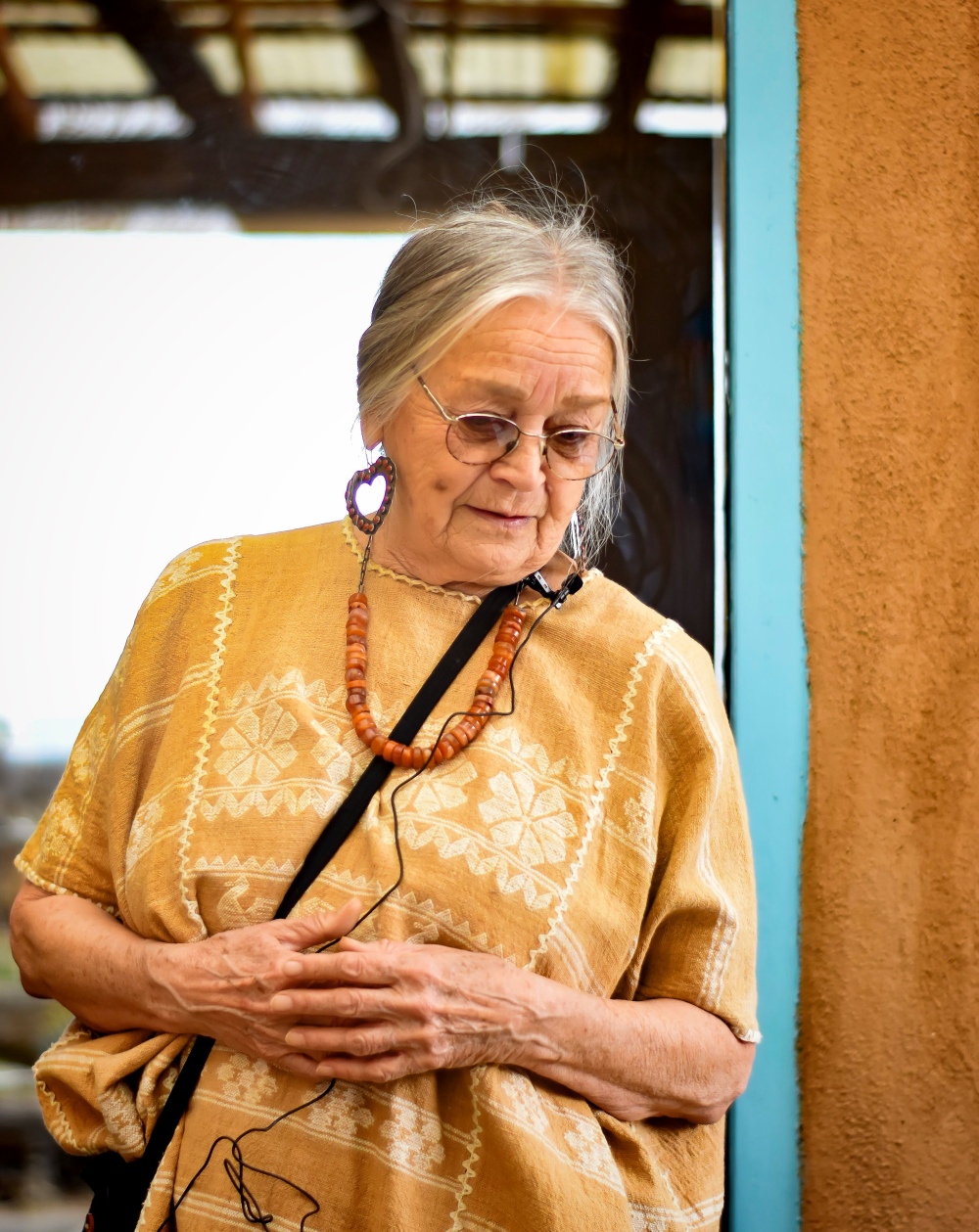
Architecture and Her Home
The processes of the Enjarradora were on the brink of being lost to history. In all the books on architecture they just had women plastering but nobody mentioned the fact that these women were the carriers of a whole technology. So I wrote about it, I was the first person to ever write about any of this. It was published in Adobe News and everybody got all excited and they began taking my picture and I started getting jobs from just from the free publicity. So then I was invited to Egypt to work for an architect called Hassan Fathy who won the Aga Khan prize in ’82 for Earth Architecture. He wrote a book called Architecture for the Poor and he built without using wheelbarrows, tapes with these technologies that were for poor people.
I was the first women to carry a contractor’s license in the northern part of the state.
That was 34 years ago. You can see for yourself my house that I built hasn’t even leaked. So you know the technology is complicated but it is all up here.
I went to Egypt and I lived there and I found them to be some of the most hospitable and generous people in the world, their hospitality literally brought me to tears.
(Anita showing our collective her home’s architecture)
This symbolizes the perfection of God, so you have the perfect half dome which is achieved by using a flattened Coca Cola can, a nail and a stick and making a compass to achieve the level and angle of the adobes. I used concrete twice in the bond beam here and the bond beam above the squinches other than that I followed the Egyptian technology down to the size of the adobes which are tiny adobes. It’s a technology that women and children can use, the adobes are so small. Have you seen old construction workers? They weigh 40 pounds, when you can make them tiny and children can throw them up like cards and they make a stronger wall because they have more joints so the entire wall has more tensile strength. This is dirt, not paint this comes from a deposit just down the road, so it is outside the cash economy and independent. So that is the adobe part, do you want to see the rest of the house?
Mud floors laid on ground grade, no cement underneath sub-floor heating, waterproof. It’s a small house. I took a long time to draw the house, thinking about okay I’m going to come in with the groceries, I am going be scared, it’s dark, where’s the light switch. You know when I am feeding people I want the dishes you know all that and how and I going to pay for this, so I would make a little money and do some work and I became an expert in mud plastering, fireplace building, restoration and I got famous I think mostly because I am woman and they thought ” oh my God she is a genius, she can use a hammer” so really that helped and little by little and I tried to incorporate all the technologies that I had learned because when I realized the kind of architecture that we had it’s like adobe is so maligned the best thing about adobe is that it melts.
What are we going to do with all the rest of this architecture? If our species doesn’t prove to be a failed experiment and there is nothing left but cockroaches in our grandchildren’s generation and we’re still alive, what kind of architecture are we going to use? Are we going to be stupid enough to do the same thing again? or are we going to use this plastic material that can be used by people of all ages that is sculptural that can be made to fit any environment, any culture, any lifestyle and that when you don’t need it any more it returns to the earth without leaving a pile of garbage.
I think children should be taught to use adobe but they aren’t, it’s a survival technique.
But the fact of the matter is that here in New Mexico we were conquered by the United States and what had been a communal and collective form of architecture that involved the entire community became ad capitalist industry and we were forced to sell our labor because we lost 80% of our land in a very short period of time. We were reduced to a landless class of cheap labor. Women were excluded automatically from this construction business and so this women’s technology was lost. So it wasn’t like we let our traditions go because we’re lazy. We do that to ourselves, we internalize all that stuff which is getting stronger now.
This is a traditional roof called latillas and it’s aspen. It’s dead wood so this is the traditional way of doing it. Usually mud is placed on top, but I used modern technologies where it applies so I have a moisture proof sealed barrier above the latillas and then I used regular insulation, it was newspaper treated with a fire retardant in those days. So that’s a traditional roof and I loved the old architecture because I was born and raised in Taos and it was an adobe village and it was so beautiful, it was so beautiful and it was basically free, outside the cash economy which capitalism cannot tolerate just as they could not tolerate our communal land ownership.
I am giving a workshop, it’s is on the heritageinspirations.com calendar on one of the processes of the Enjarradora called Alisando. I am going to take my students to the deposit and they’re going to see how it’s dug up. I’ll show them how to process it and they will have actual real adobe walls on which to make the repairs. At the same time I will take them to the Ranchos Church that simultaneously will be undergoing an annual restoration, where they will see the process of the community maintaining the architecture and the architecture teaching them. I will cook for them because after I was a painter for a while I became a writer and I published a book that is a cookbook and traces the history of food in my family which is the history of our people you know it shows the migrations and the ingredients.
There’s a painting here that is about what we are talking about, it’s called, Angels, ancestors and living walls of mud and this could be any church anywhere in the northern part of New Mexico. The church keeps the village united because no matter how many little squabbles everybody has about the hole in the road or the chicken somebody ran over or something they have to get together and cooperate and restore the building and so the building keeps the community together and the community keeps the building together and this is true living architecture and this is not something we lost because we are lazy. This was something that was taken away.
This was part of our environment. We took it for granted and I think most of us thought it was really boring and old fashioned and embarrassing and ignorant and we wanted to be gringos y con un television y todo. And that’s part of conquest, that’s part of the psychological process of colonization.
I finished my house in 1982 and it took me about 5 years to build it.
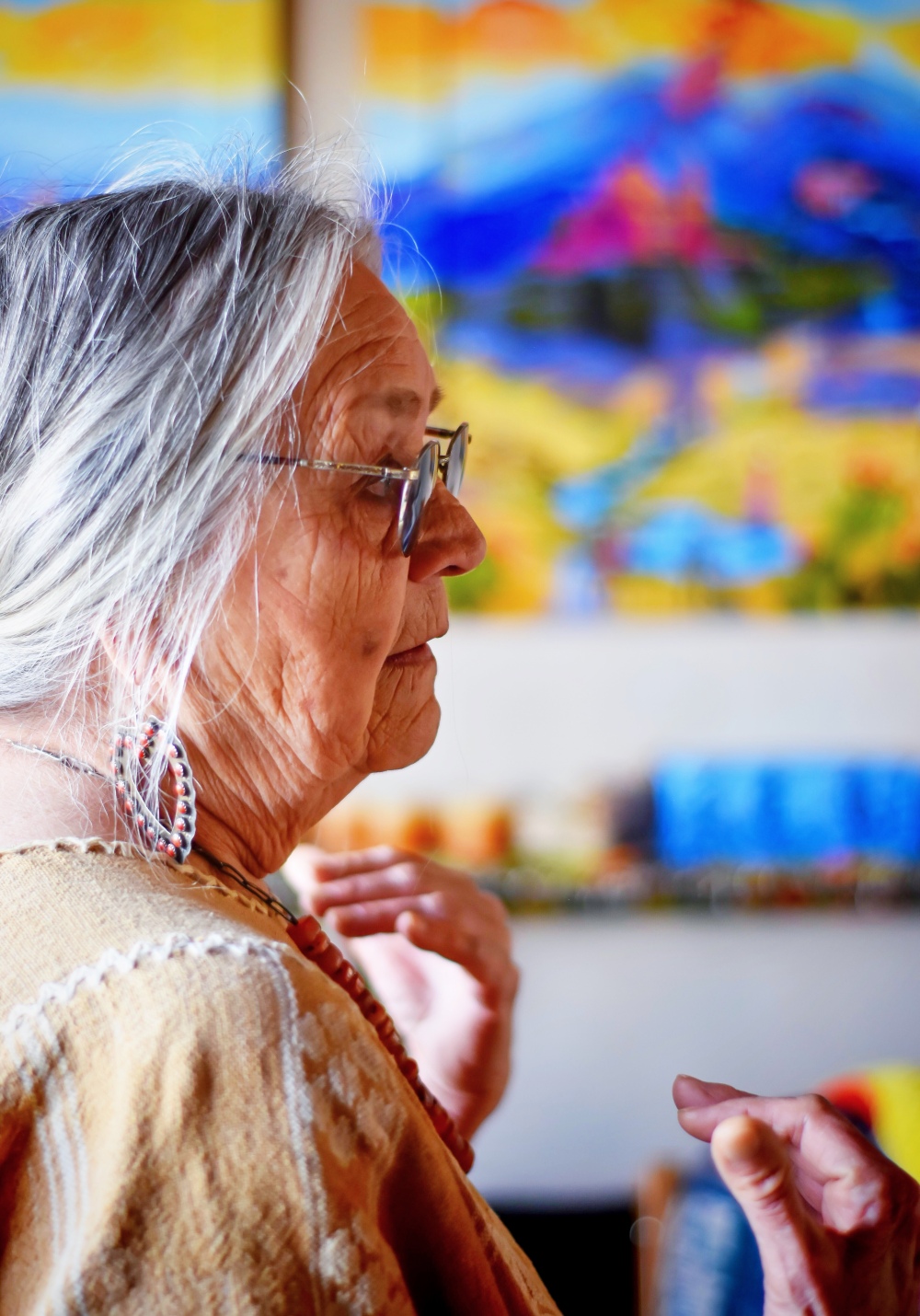
Growing up in Taos
The degree of xenophobia in Taos was almost impossible to describe. I mean it was like if you went farther than Albuquerque, you’d fall off into the void. People from the outside were like extraterrestrials to us. We had been isolated for so long. In a way, our poverty affected us, but you know with the conquest came the railroad and then came electricity, than our men went away to war, they came back with ideas and things began to change, but there was culture shock. When you walk from Taos Pueblo to downtown, you walk over 250 years. A lot of us when we leave our houses we walk 100 years still those people in my generation because it has changed so much and the dominant culture, the most palpable and to us perceptible thing about the dominant culture its dominance, the media, the language everything. So we are like those little nicho’s on the wall, we live behind the closed door where we carry on our own. It used to be culturally a different field.
One of the things about the plaza when I was growing up is that there was challenged people who lived on the plaza and everybody took care of them instead of hiding them and being ashamed of them and arresting them. We took care of them. There was an old man who lived in a wheelchair, he sold pinons and cards or something, and he paid a little boy to take his potty out and at night the policemen would roll him into the courthouse so he wouldn’t be cold.
If you were a kid and you did something wrong on the plaza, your parents knew about it before you got home and they would say “no don’t tease that man whose eating out of the garbage, for all you know he could be a saint”. This waitress would give free coffee to this guy who no se que le paso, he had kind of like a dent in his head and he sold newspapers and he didn’t take care of himself, he didn’t bathe and so she made a promise quien sabe quien to Our Lady of Guadalupe that if Our Lady answered her prayers that she would give him a bath every week. And she did. She took him home, put him in the tub, put his clothes in the washing machine and there he was every day with glowing proof that Our Lady does not abandon her people. So this is how we treated people on the plaza.
That’s one thing, and then another thing is that everything happened there, you could buy shoes, you could buy food, you could buy tools, you could buy seeds, you could get coffee, you could get drunk, you could gossip, you know there was a reason to be there, now it’s for tourists.
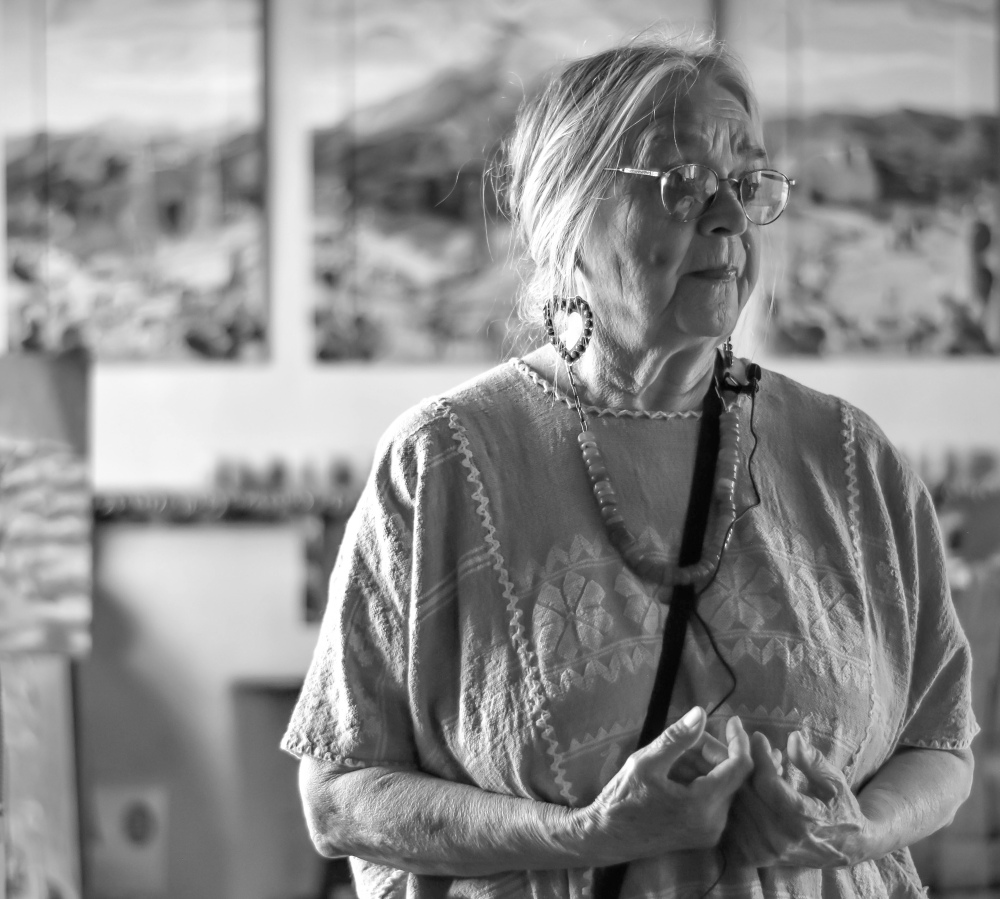
Today’s Taos
Tourism is a source of income and it’s an important source of income. I would just like to see things even out a little bit. Cultural exchange is absolutely part of our history and part of the history of our species because it happens everywhere.When there is inequality in the exchange, than someone else has more power. I don’t want outside experts interpreting the meaning of what only I can know; the only authorities that I would really accept on Native American cultures are Native Americans.
I know there are some brilliant young people in this community and they are doing some really important grassroots organizing. They see things from a necessary perspective, only they are equipped to deal with the future that’s coming so I know some really brilliant young people in this town who have taken the initiative and started all kinds of things. But you know I don’t hang on the plaza, I go to bed at 8:30.
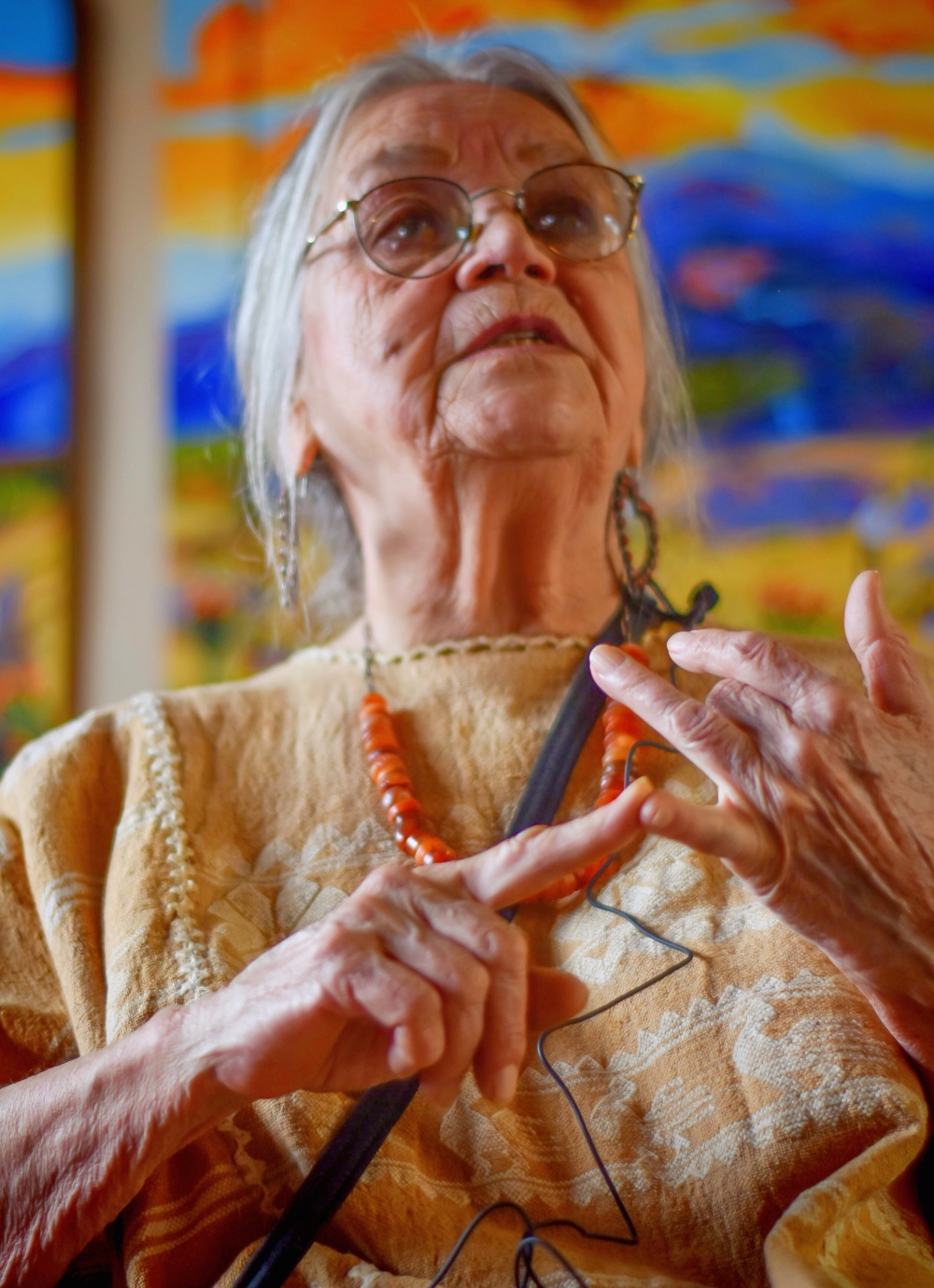
Closing thoughts
Oh I would love my son to come back. London maybe underwater in 15 years anyway. I think that’s what I think about when I think about my children, I think about our planet, you know, how long is it going to before it’s not the same any more anywhere.
I want to work with young people. I want to work with immigrant children because working with young people, the grownups are all messed up. Most people my age don’t even know how to play anymore, all they talk about is their blood pressure. So young people feel me, they keep me young, they’re our hope, they’re the future.
We could not do better than to give all the lands back to the Native Americans and then give them the power to clean it up. For three generations they’ll be so busy they won’t even care about the money because it is a big mess. Then let everything else be devoted to the children, that’s my utopia.

Photo Credits: Bobby Gutierrez
